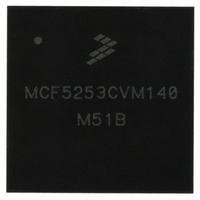MCF5253CVM140 Freescale Semiconductor, MCF5253CVM140 Datasheet - Page 357

MCF5253CVM140
Manufacturer Part Number
MCF5253CVM140
Description
IC MPU 32BIT 140MHZ 225-MAPBGA
Manufacturer
Freescale Semiconductor
Series
MCF525xr
Datasheets
1.MCF5253VM140J.pdf
(34 pages)
2.MCF5253VM140J.pdf
(8 pages)
3.MCF5253VM140J.pdf
(648 pages)
4.MCF5253VM140J.pdf
(2 pages)
Specifications of MCF5253CVM140
Core Processor
Coldfire V2
Core Size
32-Bit
Speed
140MHz
Connectivity
CAN, EBI/EMI, I²C, QSPI, UART/USART, USB OTG
Peripherals
DMA, WDT
Program Memory Type
ROMless
Ram Size
128K x 8
Voltage - Supply (vcc/vdd)
1.08 V ~ 1.32 V
Data Converters
A/D 6x12b
Oscillator Type
External
Operating Temperature
-40°C ~ 85°C
Package / Case
225-MAPBGA
Family Name
MCF5xxx
Device Core
ColdFire V2
Device Core Size
32b
Frequency (max)
140MHz
Instruction Set Architecture
RISC
Supply Voltage 1 (typ)
1.2/3.3V
Operating Supply Voltage (max)
1.32/3.6V
Operating Supply Voltage (min)
1.08/3V
Operating Temp Range
-40C to 85C
Operating Temperature Classification
Industrial
Mounting
Surface Mount
Pin Count
225
Package Type
MA-BGA
Lead Free Status / RoHS Status
Lead free / RoHS Compliant
Number Of I /o
-
Eeprom Size
-
Program Memory Size
-
Lead Free Status / Rohs Status
Compliant
Available stocks
Company
Part Number
Manufacturer
Quantity
Price
Company:
Part Number:
MCF5253CVM140
Manufacturer:
FREESCALE
Quantity:
300
Company:
Part Number:
MCF5253CVM140
Manufacturer:
Freescale Semiconductor
Quantity:
10 000
Part Number:
MCF5253CVM140
Manufacturer:
FREESCALE
Quantity:
20 000
Company:
Part Number:
MCF5253CVM140J
Manufacturer:
Freescale Semiconductor
Quantity:
10 000
- MCF5253VM140J PDF datasheet
- MCF5253VM140J PDF datasheet #2
- MCF5253VM140J PDF datasheet #3
- MCF5253VM140J PDF datasheet #4
- Current page: 357 of 648
- Download datasheet (8Mb)
18.6.2
After completion of the initialization procedure, users can transmit serial data by selecting the “master
transmitter'’ mode. If the MCF5253 is connected to a multimaster bus system, users must test the state of
the I
If the bus is free (IBB=0), the start condition and the first byte (the slave address) can be sent. The data
written to the data register comprises the address of the desired slave and the LSB is set to indicate the
direction of transfer required.
The bus free time (i.e., the time between a STOP condition and the following START condition) is built
into the hardware that generates the START cycle. Depending on the relative frequencies of the system
clock and the SCL period, users may have to wait until the I
the MBDR before proceeding with the following instructions.
An example of a program that generates the START signal and transmits the first byte of data (slave
address) is shown as follows:
CHFLAG MOVE.B
BTST.B #5, (A7)+
BNE.S CHFLAG;If it is set, wait until it is clear
TXSTART MOVE.B MBCR,-(A7);Set transmit mode
BSET.B #4,(A7)
MOVE.B (A7)+, MBCR
MOVE.B MBCR, -(A7);Set master mode
BSET.B #5, (A7);Generate START condition
MOVE.B (A7)+, MBCR;
MOVE.B CALLING,-(A7);Transmit the calling address, D0=R/W
MOVE.B (A7)+, MBDR;
IFREE MOVE.B MBSR,-(A7);Check the IBB bit of the MBSR.
;If it is clear, wait until it is set.
BTST.B #5, (A7)+;
BEQ.S IBFREE;
Freescale Semiconductor
2
C Busy Bit (IBB) to check whether the serial bus is free.
MBCR = $0
MBCR = $A0
dummy read of MBDR
MBSR = $0
MBCR = $0
Generation of START
During the initialization of the I
IBB bit of the MBSR register. If the IBB bit is set when the I
enabled, then the following code sequence should be executed before
proceeding with the normal initialization code. This issues a STOP
command to the slave device, which places it into the idle state as if it were
recently power cycled.
MBSR,-(A7);Check the MBB bit of the MBSR
MCF5253 Reference Manual, Rev. 1
2
C bus module, the user should check the
NOTE
2
C is busy after writing the calling address to
2
C module is
I
2
C Modules
18-13
Related parts for MCF5253CVM140
Image
Part Number
Description
Manufacturer
Datasheet
Request
R
Part Number:
Description:
Mcf5253 Coldfire? Microprocessor Data Sheet
Manufacturer:
Freescale Semiconductor, Inc
Datasheet:
Part Number:
Description:
Manufacturer:
Freescale Semiconductor, Inc
Datasheet:
Part Number:
Description:
Manufacturer:
Freescale Semiconductor, Inc
Datasheet:
Part Number:
Description:
Manufacturer:
Freescale Semiconductor, Inc
Datasheet:
Part Number:
Description:
Manufacturer:
Freescale Semiconductor, Inc
Datasheet:
Part Number:
Description:
Manufacturer:
Freescale Semiconductor, Inc
Datasheet:
Part Number:
Description:
Manufacturer:
Freescale Semiconductor, Inc
Datasheet:
Part Number:
Description:
Manufacturer:
Freescale Semiconductor, Inc
Datasheet:
Part Number:
Description:
Manufacturer:
Freescale Semiconductor, Inc
Datasheet:
Part Number:
Description:
Manufacturer:
Freescale Semiconductor, Inc
Datasheet:
Part Number:
Description:
Manufacturer:
Freescale Semiconductor, Inc
Datasheet:
Part Number:
Description:
Manufacturer:
Freescale Semiconductor, Inc
Datasheet:
Part Number:
Description:
Manufacturer:
Freescale Semiconductor, Inc
Datasheet:
Part Number:
Description:
Manufacturer:
Freescale Semiconductor, Inc
Datasheet:
Part Number:
Description:
Manufacturer:
Freescale Semiconductor, Inc
Datasheet:











